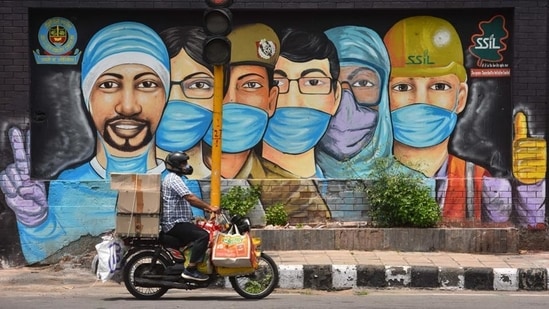Covid-19: What you need to know today
Everyone should have themselves vaccinated but not everyone will. The government, the media, non-governmental organisations, and educational institutions, should all work to break this reluctance, which, at least in the next several months when supplies lag, will actually work to India’s advantage.
For weeks, Hindustan Times has, every time it has managed to lay its hands on it (data is as difficult to find as oil), published the status of vaccine distribution across states. This is managed by the Union government, and, I must confess, I cannot understand the basis on which vaccines are distributed.

It is clearly not population. Uttar Pradesh, the most populous state in the country, received just about the same amount of vaccines as Rajasthan (till the evening of April 18), and just around 500,000 more doses than Gujarat, states with roughly a third of its population.
Bihar, with a population that is approximately 1.7 times Rajasthan and Gujarat’s (separately) received just around half the number of vaccines they did.
The generous allocations to the two western states also indicates that it is likely not active cases that is the criteria. According to the government’s own data from last week, Maharashtra, Uttar Pradesh, Karnataka, Chhattisgarh, Kerala, and Tamil Nadu are the states with the most active cases — in that order. Yet Chhattisgarh, Kerala, and Tamil Nadu have all received fewer vaccines than Bihar, which, if the data is to be believed, has won the fight against Covid-19. They have also received much fewer vaccines than Madhya Pradesh.
The government’s note on the Phase 3 of its vaccine drive hints at a definite methodology — “on the criteria of extent of infection (number of active Covid cases) and performance (speed of administration)” and warns that “wastage” will “affect the criteria” — but stops short of spelling it out.
I am sure there is a transparent and dynamic methodology, based on objective criteria on the allocation of vaccines — it’s just that we don’t know what it is.
Reports over the past few days have suggested a similar issue with the allocation of medical oxygen. The Delhi government has complained that oxygen meant for it is being diverted to Uttar Pradesh. Now Tamil Nadu has joined the chorus, saying oxygen meant for it was diverted to some other southern states. Again, I’m sure there is a transparent and dynamic methodology that is the basis for this allocation — and again, it’s just that we don’t know what it is.
It’s important to publicise these methodologies. People may disagree with them, but debate and discussion can only make them better. It’s even more important to do so because half the vaccines made in India (the policy is silent on the imports on this front) will have to be supplied to the Central Drugs Laboratory from May 1, when the country enters Phase 3 of its vaccine drive. The Union government will then distribute these to the states — and because Phase 3 is certain to be messy, at least in the initial weeks, may be even months, it makes sense to share details of the basis on which this will be done. Assuming the two local manufacturers of vaccines manage to increase their capacities to the levels they want to by June, this means the Union government will have between 50 million and 60 million doses to share with the states. In addition, the states, depending on their ability (and capacity) to strike deals with vaccine makers, will have access to another 50 to 60 million doses of these two vaccines.
There is still some confusion on Bharat Biotech’s exact capacity, but there’s congruence between the two latest statements, one from the Department of Science and Technology, and another from the company itself, putting the number at 60-70 million doses a month by July-August and 700 million doses a year, respectively. DST’s statement also speaks of a more ambitious 100 million doses a month capacity by September. So, at least from August, there will be more vaccines available (although the 50% share for states and the open market could reduce some more because of contractual export commitments that both Bharat Biotech and Serum Institute of India have).
Then there are the imports — Dr Reddy’s has said its first imports of the Sputnik V vaccine will land in May, but has steered clear of putting a number to this. Local manufacturing of Sputnik V should have started by now, but not too many details of this have been forthcoming (either from the companies or the government) adding to the asymmetry of information on the availability of vaccines.
It’s important to fill these data gaps — a congruent, fair, vaccine policy is impossible without doing so.
Everyone should have themselves vaccinated but not everyone will. The government, last-mile public health workers, the media, non-governmental organisations, and educational institutions, should all work to break this reluctance, which, at least in the next several months when supplies lag, will actually work to India’s advantage. But eventually, everyone should get vaccinated; no one is safe till everyone is. The government can also help by addressing all concerns regarding vaccines (its response to the Brazilian drug regulator’s criticism of Bharat Biotech’s manufacturing practices has been inadequate) and by being transparent about adverse effects, including deaths. It’s move, on Wednesday, to release data that showed that just 0.02% people who received one dose of the Covishield vaccine, and 0.03% of those that received both doses subsequently tested positive for Covid-19, is just the kind of reassurance India needs. The numbers are an equally reassuring 0.04% and 0.04% in the case of Covaxin.





